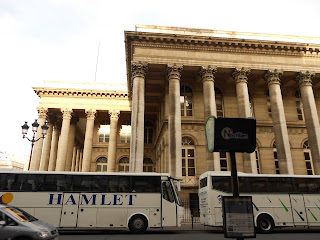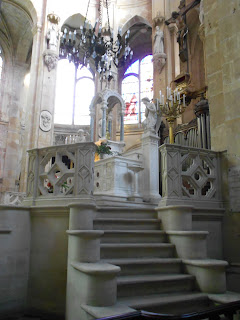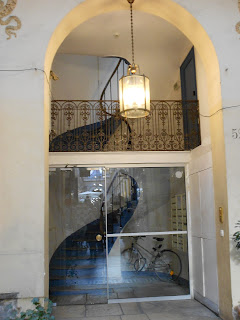And a disclaimer: the view screen on my camera is broken so when I take pictures I have no way of knowing if they're good or not. I hope for the best, but this is why many are oddly centered or blurry. Sadly, it makes it so that I hardly ever get good pictures of far-away stained glass or art in the churches.
The 2nd is the smallest arr, only almost one square km (about .38 square miles), but like the 1st it has a large number of businesses in comparison to its size. Unlike the 1st, though, the 2nd's business life is not at all tourist-based: it is the home to most of Paris' financial district and the current Bourse, the stock exchange. The western end of this arr is bounded by the Opera/grand magasin area - which I talked about a bit in this post. It's a pretty bourgeois, commercial area with a lot of later 19th century architecture, wider streets, and not a lot of residences.
Here is the Bourse today (apparently it's a favorite place to park tour buses on the weekends):
It's only about a 7 minute walk or so from the old Bourse, which I discussed in the post on the 1st arr. It's also very close to the Louvre and Palais Royal - so you can tell that this is a wealthy, higher-class area of the city.
This place is obviously no longer the headquarters of the Bank of France (does the Bank of France even exist anymore? I'm not up on the French banking system) but I don't really know what it is. It's a government building, though - you can tell because it has a huge flag on the entrance. Anyway, it's in the same area as the current financial center.
So this area of the 2nd arr is pretty calm and staid - a complete contrast to the eastern end of the arr, which is, keep in mind, less than a third of a mile away. I knew much more about this neighborhood.
To the east the 2nd arr's boundary is the Rue St Denis. This street has been notorious since the early Renaissance for having a thriving, incorrigible trade in um, ladies of the night. And that particular business is still going strong there, although the red light district now centers around the Pigalle area, a shortish walk away.
Police as far back as the 14th century have complained how these ladies had their rooms all along this street - in fact this very street gave rise to the term "bordello":
You can see that this street is very narrow and not paved as such - this section has a definite medieval feel, and boasts some of the best-preserved medieval points of interest outside of the 4th and 5th arrs. Now there are lots of Middle Eastern fast food restaurants, pizza places, and cheap clothing shops. Funnily enough, I took this shot of the historical prostitution row in front of a church:
These two things on the outside of this rather unassuming church made me more interested in going inside it instead of continuing down Rue St Denis:
"St Leu and St Gilles parish, diocese of Paris. Chapter church of the knights of the Order of St Sepulchre of Jerusalem"
The Latin: house of God and door to heaven. The Hebrew: YHWH (I think, someone correct me if I'm wrong - aren't you glad I'm passably bad at so many languages?) So...these things probably don't look like much, but together they said to me, "Knights Templar!!"
Okay, I don't necessarily think the knights of St Sepulchre were like the Templars, but the Hebrew inside the triangle and the point this church makes of mentioning its ancient connections to the orders in Jerusalem definitely makes me think it was part of the whole secret church society thing back in the day.
This is just outside my realm of knowledge, but I do find those orders fascinating.
As I looked around the church my suspicions were confirmed: they kept referring to the Jerusalem knights, how they were separated from their home churches, and it was founded in just the right time period, in 1235.
Anyway, it's a pretty cool church inside, though the outside is not much.
It's bright and airy (in stark contrast to the next church) and the stained glass was nice. There was a medieval crypt towards the front housing the bones of St Helen; it was super cool but not lit and there were people praying so I didn't want to take flash pictures. I'm glad I went in, although I knew pretty much nothing about it.
The church I was actually heading for was Notre Dame des Victoires, one of only three places of note in the 2nd arr (including also the Bourse and the national library, which I'll get to in a bit). I had never been there and didn't know much about this one, either, except that it's pretty well known.
Before I got there I went through the Place des Victoires, a little shopping circle a couple of blocks down from the Louvre. The statue is Louis XIV, who indeed had probably more than his fair share of victories. The buildings are mostly 17th century, to go with the 17th century king.
Moving right along...here is the facade of Notre Dame des Victoires. I was struck by how much it reminded me of the 17th century churches in Italy - in shape and decoration. I don't particularly like that style, though.
It looked rather dead from the outside, so the inside was a bit of a surprise. Upon entering my thoughts were something like, "holy...holiness!" I immediately got the impression that this is the most religiously active church I've seen in outside of probably Sacre Coeur.
The number of candles! They must spend a good deal of time worrying about fires. I go into a LOT of these churches, but I have never seen this many candles lit. This church seems to be pushing a few saints (or soon-to-be saints) pretty hard.
Here is St Theresa's (of Lisieux...I think) shrine. Poor thing, a weird reflection is making her eye look rather deformed.
And here's one of a couple that is titled Bienheureux...which means very happy, so I'm not sure if they're venerable or blessed. Sorry. Also this picture sucks.
And just next to these two was one for the last pope. Every shrine in this church had at least 100 candles I would say.
It was one of the most dark and somber churches I've visited here and I felt distinctly unwelcome taking pictures. I tried to get some shots of the frescoes around the front alter, which were really nice, but when I got home I saw that they didn't come out at all.
So, I've gone through the western and eastern ends of the 2nd arr, but what is in the middle? Shopping. Lots of it. One of the oldest shopping districts in Europe, actually.
Before I get to that, though, I read that the former location of France's national library was near the shopping area so I went to check it out. I was expecting a large, imposing, possibly Baroque or neo-Classical building; this is what I was not expecting:
Most of the library appears to be in those metal trailers. You can see a bit of the building in between them but I couldn't even get into the courtyard. Oh well.
So, the middle of the 2nd arr is home to the first malls ever. In the mid-late 18th century some rich people enclosed some of their private property, tiling the floors and putting in glass ceilings, and renting out the space to merchants. They would set up shops in long rows called passages, often connecting, and people could stroll through and go to a wide variety of shops without going outside.
Most of these are gone but this few in the 2nd arr have survived. Today they have an interesting mix of shops, one of which - an antique book seller - I had to really restrain myself from going into. They're pretty narrow and don't get a ton of shoppers today but they're nice for an interesting stroll.
Aside from these passages, there is also a whole section of the middle area that is blocked off to cars, all made up of narrow streets filled with shops, restaurants and cafes. It's very cool, and a great place to spend a leisurely day shopping. If you are interested in the everyday street fashion of Parisians, definitely check out the Montorgueil section of the 2nd arr.
Finally, the last things! In my wanderings, the 2nd arr has offered the most amusing restaurant/cafe names of any other area. My favorites:
These two happen to be across the street from each other. The first one is called "The White Wolf" and the second is "The Three Little Pigs."
Speed Rabbit Pizza just made me laugh.
Things not to miss in the 2nd: the Montorgueil shopping area and the enclosed passages, and the St Leu St Gilles church, if you're into that sort of thing. Everything else I discussed was interesting, but not imperative to see.





























No comments:
Post a Comment